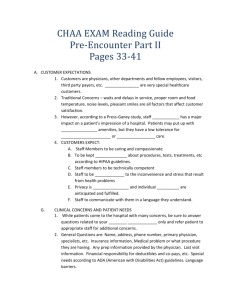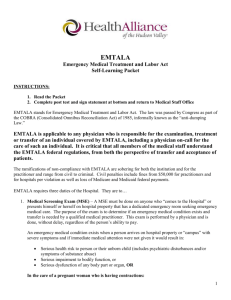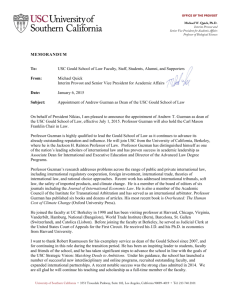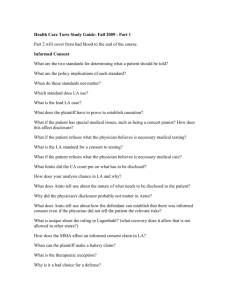Houston Hospital Prevails in Federal EMTALA Suit
advertisement
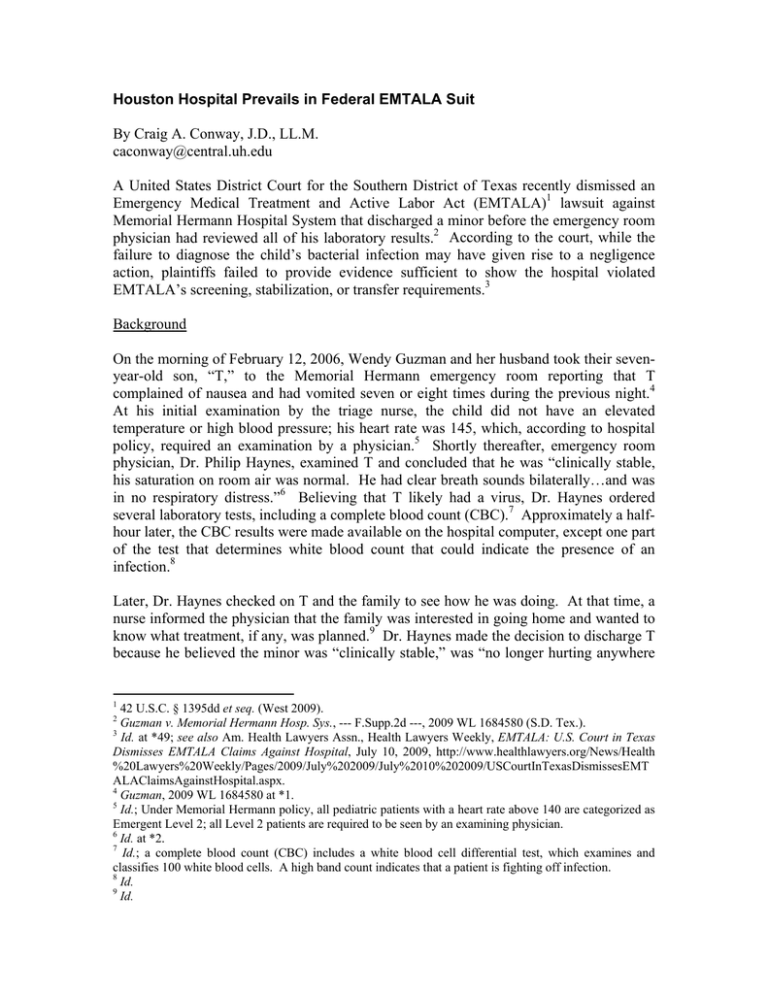
Houston Hospital Prevails in Federal EMTALA Suit By Craig A. Conway, J.D., LL.M. caconway@central.uh.edu A United States District Court for the Southern District of Texas recently dismissed an Emergency Medical Treatment and Active Labor Act (EMTALA)1 lawsuit against Memorial Hermann Hospital System that discharged a minor before the emergency room physician had reviewed all of his laboratory results.2 According to the court, while the failure to diagnose the child’s bacterial infection may have given rise to a negligence action, plaintiffs failed to provide evidence sufficient to show the hospital violated EMTALA’s screening, stabilization, or transfer requirements.3 Background On the morning of February 12, 2006, Wendy Guzman and her husband took their sevenyear-old son, “T,” to the Memorial Hermann emergency room reporting that T complained of nausea and had vomited seven or eight times during the previous night.4 At his initial examination by the triage nurse, the child did not have an elevated temperature or high blood pressure; his heart rate was 145, which, according to hospital policy, required an examination by a physician.5 Shortly thereafter, emergency room physician, Dr. Philip Haynes, examined T and concluded that he was “clinically stable, his saturation on room air was normal. He had clear breath sounds bilaterally…and was in no respiratory distress.”6 Believing that T likely had a virus, Dr. Haynes ordered several laboratory tests, including a complete blood count (CBC).7 Approximately a halfhour later, the CBC results were made available on the hospital computer, except one part of the test that determines white blood count that could indicate the presence of an infection.8 Later, Dr. Haynes checked on T and the family to see how he was doing. At that time, a nurse informed the physician that the family was interested in going home and wanted to know what treatment, if any, was planned.9 Dr. Haynes made the decision to discharge T because he believed the minor was “clinically stable,” was “no longer hurting anywhere 1 42 U.S.C. § 1395dd et seq. (West 2009). Guzman v. Memorial Hermann Hosp. Sys., --- F.Supp.2d ---, 2009 WL 1684580 (S.D. Tex.). 3 Id. at *49; see also Am. Health Lawyers Assn., Health Lawyers Weekly, EMTALA: U.S. Court in Texas Dismisses EMTALA Claims Against Hospital, July 10, 2009, http://www.healthlawyers.org/News/Health %20Lawyers%20Weekly/Pages/2009/July%202009/July%2010%202009/USCourtInTexasDismissesEMT ALAClaimsAgainstHospital.aspx. 4 Guzman, 2009 WL 1684580 at *1. 5 Id.; Under Memorial Hermann policy, all pediatric patients with a heart rate above 140 are categorized as Emergent Level 2; all Level 2 patients are required to be seen by an examining physician. 6 Id. at *2. 7 Id.; a complete blood count (CBC) includes a white blood cell differential test, which examines and classifies 100 white blood cells. A high band count indicates that a patient is fighting off infection. 8 Id. 9 Id. 2 other than the place where his IV was,” and “the family wanted to go home.”10 The physician also believed that T had a virus that was affecting his upper respiratory system, but could also have been affecting his gastrointestinal system.11 The Guzmans left the hospital with the instruction to return if their son’s condition worsened or did not improve within 24 hours.12 At the time of discharge, Dr. Haynes had not seen the white blood cell differential test results; as a result, he did not know that the level was extremely high – indicating a bacterial infection.13 It is important to note that Dr. Haynes testified in his deposition that if he had, in fact, seen the elevated white blood band count results he would have reevaluated T and told the family about the abnormal lab values, admitted the child to the hospital, ordered a blood culture, and spoken with the child’s primary care physician about possibly giving T antibiotics.14 The following morning, the Guzmans brought T back to the Memorial Hermann emergency room; T complained of fever, vomiting, diarrhea, and abdominal and chest pain.15 Dr. Haynes was not on duty, and instead, Dr. Mohammed Siddiqi ordered several tests to be performed.16 Dr. Siddiqi believed that T possibly had pneumonia or sepsis – a life-threatening illness. As the child’s condition worsened throughout the morning, Dr. Siddiqi ordered that T be transferred to the pediatric intensive care unit at Memorial Hermann Children’s Hospital.17 Approximately two hours later, Dr. Erickson accepted transfer of T on behalf of Memorial Hermann Children’s, but indicated that it lacked a bed for him.18 Dr. Siddiqi then arranged for an ambulance company to transport T to Memorial Hermann Children’s.19 However, Dr. Erickson disagreed and said that he wanted T transported via the pediatric transport team instead of by ambulance.20 At that time, the transport team was en route to Beaumont, Texas, to pick up another patient. Meanwhile, it became necessary to intubate T to protect his airway and respiratory system.21 Approximately two hours later, Dr. Siddiqi went to the Guzmans to “discuss plan of care…and the delay of transfer due to Transport team picking up another patient in Beaumont,” first.22 While in the emergency room, T had a severe allergic reaction to one of the medications used for the intubation causing his body temperature to increase 10 Guzman, 2009 WL 1684580 at *2. Id. 12 Id. 13 Id. at *3. 14 Id. 15 Id. 16 Guzman, 2009 WL 1684580 at *3. 17 Id. 18 Id. A nurse testified in her deposition that bed availability happens fairly quickly, typically “within an hour.” 19 Id. 20 Id. According to the pediatric physician, the transport team could provide a higher level of care during transport than a standard ambulance because the team included a pediatric critical care nurse, a respiratory therapist, a paramedic, and could include a physician. 21 Guzman, 2009 WL 1684580 at *3. 22 Id. at *4. 11 significantly in a short period.23 A nurse attempted to locate Dr. Siddiqi but learned that he had left the hospital after his shift was over.24 Another emergency room physician, Dr. David Nguyen, examined T and noted his temperature was 107.9 degrees; he ordered ice packs and cooling blankets be applied.25 The child’s temperature subsequently reached 111.2 degrees. Approximately three hours after the initial request to transfer T to Memorial Hermann Children’s pediatric intensive care unit (and still waiting for the pediatric transport team), the child was transported by Life Flight helicopter where he received immediate care and was hospitalized in the intensive care unit.26 T remained at Memorial Hermann Children’s Hospital for several weeks recovering from septic shock which caused organ injury.27 Though his condition improved, he requires ongoing medical treatment and therapy.28 Guzman’s EMTALA Claim Wendy Guzman, individually and on behalf of “T” filed suit against Memorial Hermann Hospital System and others asserting a claim under EMTALA and state-law negligence.29 More specifically, Guzman’s EMTALA claims alleged that the hospital failed to provide T with an appropriate medical screening examination during their first visit to the emergency room, failed to stabilize his condition before discharging him that day, and failed to provide an appropriate transfer of T on the second day.30 Memorial Hermann argued that Guzman failed to state a claim under EMTALA. The hospital argued that the family asserted a negligence claim, i.e., that the doctor had failed to read laboratory test results, not a failure of the hospital to provide tests given to other, similar patients.31 The hospital moved for summary judgment on the matter. EMTALA Congress enacted EMTALA “to prevent patient dumping,” – the practice of refusing to treat patients who are unable to pay.32 The Act requires a hospital to provide “an appropriate medical screening examination” to any person who enters the emergency room for the purpose of determining whether or not an emergency medical condition exists.33 Pursuant to the law, an “emergency medical condition” is defined as: 23 Id. Id. 25 Id. 26 Guzman, 2009 WL 1684580 at *4. 27 Id. 28 Id. 29 Id. at *1. 30 Id. at *4. 31 Id. 32 Id. at *8 (citing Marshall v. East Carroll Parish Hosp., 134 F.3d 319, 322 (5th Cir.1998)). 33 Id.; 42 U.S.C. § 1395dd(a) (West 2009). 24 a medical condition manifesting itself by acute symptoms of sufficient severity…such that the absence of immediate medical attention could reasonably be expected to result in (i) placing the health of the individual…in serious jeopardy, (ii) serious impairment to bodily functions, or (iii) serious dysfunction of any bodily organ or part…34 If a hospital detects the presence of an emergency medical condition, it must, utilizing the staff and facilities available, provide treatment to stabilize the condition or transfer the patient to another facility.35 If an individual at a hospital has an unstabilized emergency medical condition, the hospital may not transfer the patient unless he or she requests it, in writing, or a “physician has signed a certification that based upon the information available at the time of transfer, the medical benefits reasonably expected from the provision of appropriate medical treatment at another medical facility outweigh the increased risks to the individual…and…the transfer is an appropriate transfer.”36 What EMTALA does not do is establish a malpractice cause of action or a nationalized standard of care.37 The three possible EMTALA causes of action against Memorial Hermann Hospital in this case centered on failing to perform an appropriate medical screening examination, failing to stabilize an emergency medical condition before transfer or discharge, and failing to conduct an appropriate transfer.38 Responding to the claims asserted, the court published a thorough 46-page opinion, addressing all matters presented by the parties. Due to space limitations, only a brief review of the court’s central opinion is discussed below. The “Appropriate Medical Screening” Claim The court first conducted an analysis of whether Memorial Hermann provided an “appropriate medical screening” examination of T. Courts have uniformly held that whether an examination is appropriate is determined “by whether it was performed equitably in comparison to other patients with similar symptoms,” not “by its proficiency in accurately diagnosing the patient’s illness.”39 In other words, the plaintiff must show 34 42 U.S.C. § 1395dd(b)(1)(A) (West 2009). 42 U.S.C. § 1395dd(b)(1)(A), (B) (West 2009). 36 42 U.S.C. § 13955dd(c)(1) (West 2009). 37 Guzman, 2009 WL 1684580 at *8 (citing Marshall, 134 F.3d at 322). See also Bryans v. Rectors & Visitors of Univ. of Va., 95 F.3d 349, 351 (4th Cir.1996) (EMTALA’s “core purpose is to get patients into the system who might otherwise go untreated be left without a remedy” because traditional medical malpractice law affords no claims for failure to treat); Hardy v. New York City Health & Hosp. Corp., 164 F.3d 789, 795 (2nd Cir.1999) ([t]he “core” purpose of EMTALA is to prevent hospitals from failing to examine and stabilize uninsured patients who seek emergency treatment); Brooks v. Maryland Gen. Hosp., Inc., 996 F.2d 708, 710 (4th Cir.1993) (“[u]nder traditional state tort law, hospitals are under no legal duty to provide [emergency] care. Accordingly, Congress enacted EMTALA to require hospitals to continue to provide it”). 38 Guzman, 2009 WL 1684580 at *9. 39 Id. at *10 (citing Marshall, 134 F.3d at 322); Reynolds v. MaineGeneral Health, 218 F.3d 78, 84 (1st Cir.2000) (the plaintiff must proffer evidence “sufficient to support a finding that she received materially different screening than that provided to others in her condition”). 35 that the hospital treated the patient differently from other patients with similar symptoms. However, a minor deviation from a hospital’s screening policy is insufficient to establish an EMTALA violation.40 Guzman argued that because the initial treating physician failed to review all laboratory results and to accurately diagnose, or rule out, a bacterial infection, as well as allegedly violating other hospital triage policies, that the physician failed to appropriately screen T. Memorial Hermann argued that Guzman’s claim is indicative of a negligence action and not an EMTALA violation.41 In line with other, similar legal decisions, the court concluded that an emergency room physician is only “required by EMTALA to screen and treat the patient for those conditions the physician perceives the patient to have.”42 In this case, the court wrote, the child received a “thorough physical examination” by Dr. Haynes and was found to be “clinically stable.”43 It further noted: …two nurses and one doctor examined T and assessed his physical condition. They inquired about his symptoms, took a medical history, physically examined him, ordered a CBC, reviewed all the results except the white blood manual differential, and provided treatment. The case law makes clear that such a screening examination is reasonably calculated to identify the existence of an emergency medical condition, even if the examination does not accurately reveal the patient’s actual medical condition.44 Based upon this conclusion and a finding that the screening procedures used to evaluate T were consistent with hospital policy, the court deemed summary judgment appropriate. The court also held that the failure to check T’s vital signs every two hours was a de minimis violation of the hospital’s screening policies.45 Duty to Stabilize Not Triggered Under EMTALA, if a hospital detects the presence of an “emergency medical condition,” it must take measures to “stabilize” the condition prior to transfer or discharge.46 According to the law, “stabilize” means “to provide such medical treatment of the condition as may be necessary to assure, within reasonable medical probability, that no material deterioration of the condition is likely to result from or occur during the transfer of the individual from a facility.”47 The Fifth Circuit has defined “to stabilize” as “[t]reatment that medical experts agree would prevent the threatening and severe 40 See Repp v. Anadarko Mun. Hosp., 43 F.3d 519, 523 (10th Cir.1994). Guzman, 2009 WL 1684580 at *12. 42 Id. (citing Hunt v. Lincoln Cty. Mem. Hosp., 317 F.3d 891, 893 (8th Cir.2003)). 43 Id. at *13. 44 Id. 45 Id. at *29. 46 Id. at *33. 47 Id.; 42 U.S.C. § 1395dd(e)(3)(A) (West 2009). 41 consequence of the patient’s emergency medical condition while in transit.”48 Additionally, each federal circuit has held that a hospital must have “actual knowledge” that the patient has an unstabilized medical emergency.49 Memorial Hermann argued that no duty to stabilize arose because the emergency room staff did not know that T had an emergency medical condition.50 According to the hospital, the treating physician declared T as stable at all times and argued that it does not matter what the physician may have known, but only what he actually knew at the time of treatment.51 In response, Guzman argued that the hospital’s “corporate knowledge” determines whether the hospital had actual knowledge of the child’s condition.52 Guzman argued that because the laboratory technician and hospital computer knew of the child’s elevated white blood band count (even though the treating physician did not) – the hospital had actual knowledge of the bacterial infection and thus required stabilization treatment.53 The court disagreed with Guzman’s assertion and noted that whether a patient is, in fact, suffering from an emergency medical condition is “irrelevant for purposes of [EMTALA].”54 The court found that at the time of his discharge, T was: …not in acute distress. He had no difficulty breathing and had normal blood gases, and had stopped vomiting. Nothing in the history, examination, and the CBC (absent the band count) showed that the absence of immediate additional medical treatment would put the patient’s health in ‘serious jeopardy, serious impairment to bodily functions, or serious dysfunction of any bodily organ or part.’55 Further, the court was not bought-in by Guzman’s “corporate knowledge” theory. Instead, the court wrote that “actual detection” or “actual knowledge” is required to trigger the duty to stabilize – and noted that the treating physician lacked such knowledge.56 Thus, the court concluded summary judgment was appropriate in favor of Memorial Hermann because the child’s emergency medical condition was “not readily apparent or visible to the naked eye, … and T had no acute symptoms of severity showing the existence” of such condition.57 48 Id. (citing Burditt v. United States Dep’t of Health & Human Servs., 934 F.2d 1362, 1369 (5th Cir.1991)). 49 Roberts ex rel. Johnson v. Galen of Virginia, Inc., 325 F.3d 776 (6th Cir.2003). 50 Guzman, 2009 WL 1684580 at *34. 51 Id. 52 Id. 53 Id. 54 Id. at *36 (citing Harris v. Health & Hosp. Corp., 852 F.Supp. 701, 703 (S.D.Ind.1994)). 55 Id. at *37. 56 Guzman, 2009 WL 1684580 at *37. 57 Id. at *38. Failure to Appropriately Transfer Claim Finally, to prevail under EMTALA’s transfer provision, a plaintiff must sufficiently show the presence of (1) an emergency medical condition; (2) the hospital had actual knowledge of the medical condition; (3) the patient was not stabilized prior to transfer; and (4) the transferring hospital did not obtain the proper consent or physician certification before transfer and failed to follow appropriate transfer procedures.58 Memorial Hermann argued that Guzman’s claim that it failed to coordinate the transfer “in an appropriate and timely manner” does not allege an EMTALA violation because there is no duty to complete a transfer within a specified period of time.59 However, Guzman alleged more than that. Ms. Guzman argued that the hospital did not attempt to locate and transfer T to another children’s hospital with a pediatric intensive care unit, that transfer was inappropriately delayed due to the transport team being en route to Beaumont, and that the family was not provided with the proper information, including a “summary of the risks and benefits” of transferring T.60 The court responded that if a patient is “stabilized,” a hospital may transfer him or her without the limitations imposed under EMTALA.61 However, that was not the case with T. It was undisputed that T had an emergency medical condition being pneumonia or sepsis as determined by Dr. Siddiqi on the second day at the emergency room. However, evidence was produced by the hospital that Wendy Guzman had signed a form “request[ing] transfer to the Receiving Hospital.”62 There was insufficient evidence to conclude that Ms. Guzman actually made the request to transfer T instead of the transfer being suggested or simply implied by the hospital presenting the form for Ms. Guzman to sign. Additionally, Dr. Siddiqi signed a “Memorandum of Transfer” form which included a certification the benefits of transfer outweighed the risks of not transferring the child.63 Guzman additionally argued that transfer was inappropriate because the transport team was en route to Beaumont and there were no beds at Memorial Hermann Children’s pediatric ICU to place T.64 The court did not buy the argument. The fact that the children’s pediatric unit did not have a bed readily available did not, by itself, create an EMTALA violation. EMTALA states that an appropriate transfer is one in which the receiving hospital “(i) has available space and qualified personnel for the treatment of the individual, and (ii) has agreed to accept the transfer of the individual and to provide appropriate medical treatment.”65 Both requirements must be met. However, the court noted, simply because there was a delay in obtaining a bed for T did not violate the 58 Id. at *40 (citing Baber v. Hosp. Corp. of America, 977 F.2d 872 (4th Cir.1992)). Id. Instead, Memorial Hermann suggested that the Guzmans were asserting a negligent delay of transfer, which is not actionable under EMTALA. 60 Id. 61 Guzman, 2009 WL 1684580 at *40. 62 Id. at *41. 63 Id. at *42. 64 Id. at *44. 65 42 U.S.C. § 1395dd(c)(2)(B) (West 2009). 59 “available space” requirement of § 1395dd)(c)(B)(i).66 transfer within a certain time. EMTALA does not require Conclusion The court concluded its opinion by noting the allegations and evidence involve negligence and medical malpractice, not EMTALA liability.67 It granted the hospital’s motion for summary judgment as to EMTALA but left open Guzman’s claims for medical negligence. The Guzman opinion does not shatter any existing law relating to EMTALA. In fact, it reinforces several key requirements – including the necessity of showing that a hospital had “actual knowledge” of an emergency medical condition and distinguishing EMTALA claims from medical negligence actions. The opinion is one that should be read and utilized by plaintiffs asserting EMTALA violations against healthcare providers, and by hospitals and physicians defending such claims. Health Law Perspectives (July 2009) Health Law & Policy Institute University of Houston Law Center http://www.law.uh.edu/healthlaw/perspectives/homepage.asp 66 67 Guzman, 2009 WL 1684580 at *45. Id. at *49.

